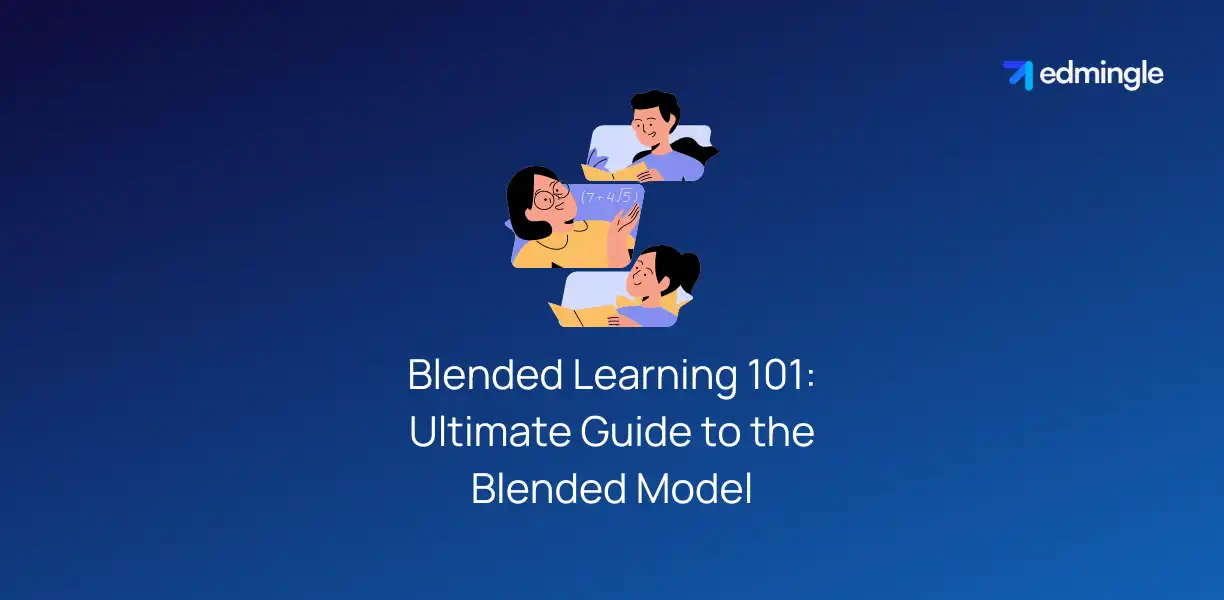
Picture a classroom where blackboards meet chatbots and textbooks blend with touchscreens.
This is what the vibrant world of blended learning looks like. When combined with an LMS, it becomes a powerful synergy of traditional teaching methods with the agility of digital.
And above all, it isn’t just a passing trend but a powerful educational shift.
In this blog, we’ll explore in depth & understand how it can reshape the academic landscape. And more importantly, how can you navigate in the new blended model of learning.
What is ‘Blended Learning’?
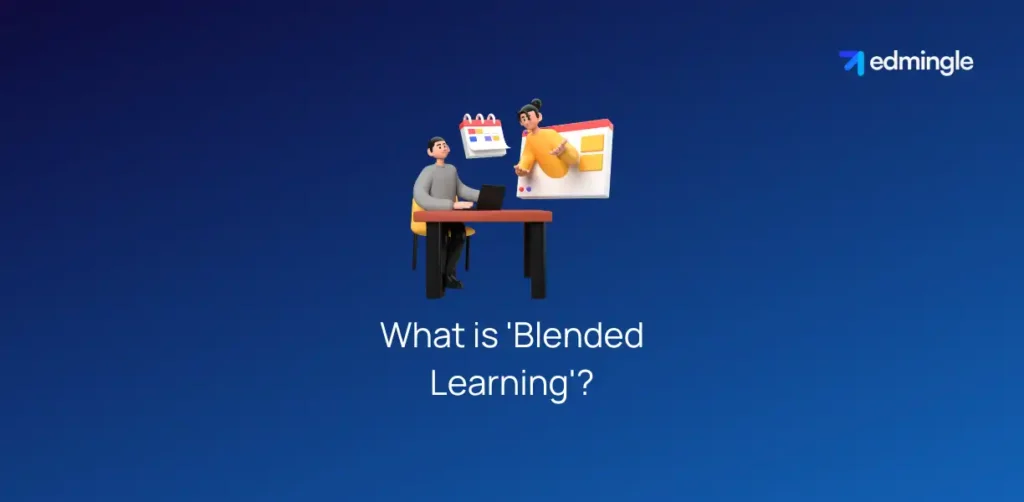
At its core. The blended model integrates face-to-face classroom instruction with online components. Hence, creating a dynamic environment that caters to diverse learner needs.
The term is occasionally interchanged with “hybrid learning” or “mixed-mode instruction.”
Regardless of this, focus on crafting an experience that taps into the best of both worlds remains steadfast. The engagement of traditional classrooms and the adaptability of digital technology platforms.
This fusion seeks to optimize instruction, facilitate accessibility and promote individualized pathways.
Also read about hybrid learning management systems.
Benefits of the Blended Model of Learning [for Learners & Organizations]
We can now come to the conclusion that it is a transformative approach. One that’s reshaping the way we think about teaching and learning.
So, the major benefits of this model are listed as follows:
For Learners:
| 1.Personalized Paths: The blended model offers adaptive experiences, allowing learners to progress at their own pace. This means faster learners can advance without waiting. While those needing more time can do so without feeling pressured. |
| 2.Flexible Access: Learners can comfortably switch between offline and online modes. This flexibility accommodates different habits and schedules, making education more accessible and convenient. |
| 3.Immediate Feedback: This model, via online assessments & quizzes, can provide instant feedback. Thereby, helping learners identify areas for improvement in real-time. |
| 4.Skill Development: Beyond just academic knowledge, the blended method often incorporates digital literacy. Hence, fostering important 21st-century skills like critical thinking, information analysis and self-paced learning. |
For Organizations:
| 1.Cost-Effective: Incorporating online components can reduce your operational costs, material and venue hiring expenses. Over time, this can lead to significant savings. |
| 2.Scalable: Organizations can reach a wider audience without the need for larger physical spaces. Thereby strengthening scalability & flexibility. |
| 3.Data-Driven Decisions: Modern LMS platforms offer analytics and insights into learner progress and course efficacy. This can inform future curricular decisions while ensuring continuous improvement. |
| 4.Enhanced Collaboration: Online forums, group projects and discussion boards can foster collaboration among learners. Thereby, improving their social learning skills. |
| 5.Quick Updates: Unlike printed learning materials, digital content can be quickly updated. This ensures that learners always have access to the most recent and relevant information. |
Difference Between Hybrid Learning and Blended Learning
Hybrid and blended; both methods integrate online educational materials and opportunities for online interaction with traditional classroom methods.
However, the former often involves replacing some traditional face-to-face instruction with online learning. While the latter mixes online educational resources & activities with traditional classroom teaching.
Without significantly reducing face-to-face teaching time, aiming to enhance and supplement the learning experience.
Also read: Hybrid Learning vs Blended Learning.
Some Possible Limitations of the Blended Learning Model
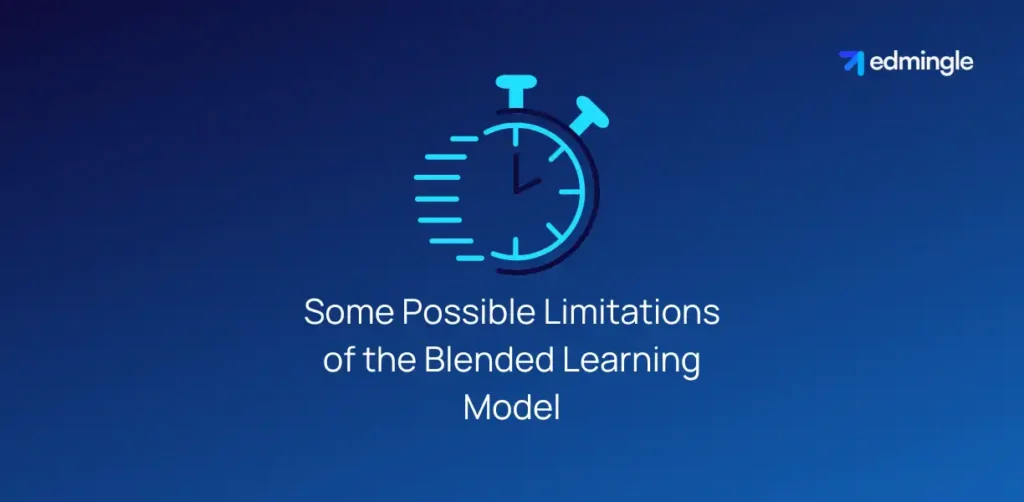
Though considered a transformative approach, it’s not without its challenges. And understanding these potential limitations is essential for harnessing its full potential.
Here are the possible limitations of the blended model:
- Tech Infrastructure and Access: Not everyone has access to the necessary technology or a stable internet connection. This digital divide can lead to disparities in experiences and outcomes.
- Learning Curve: Both trainers and learners might face a steep learning curve. The time & effort required to familiarize with these platforms can initially seem overwhelming.
- Loss of Personal Connection: While online interactions can be engaging, they sometimes lack depth. The potential for miscommunication or feelings of isolation can be higher.
- Distractions & Lack of Motivation: The online environment is full of distractions and hence, there is a need for maintaining focus & motivating learners.
- Over-reliance on Technology: While tech can enhance the training process, over-reliance on it can be detrimental. In case of outages or technical glitches, it can disrupt the process.
- Assessment Challenges: Ensuring the integrity of online assessments & proctoring can be challenging. There’s potential for dishonesty or misuse.
- Less Hands-on: Subjects that require physical practice or lab work might not translate as effectively to a blended format. To know more about this, check our article on the perfect LMS strategy for maintaining a balance.
- Potential for Inequity: The blended approach can cater to diverse learning styles. But it might unintentionally favor those who are more digitally literate.
While blended learning addresses major pain points. It’s essential to approach its integration thoughtfully.
5 Blended Learning Model Types
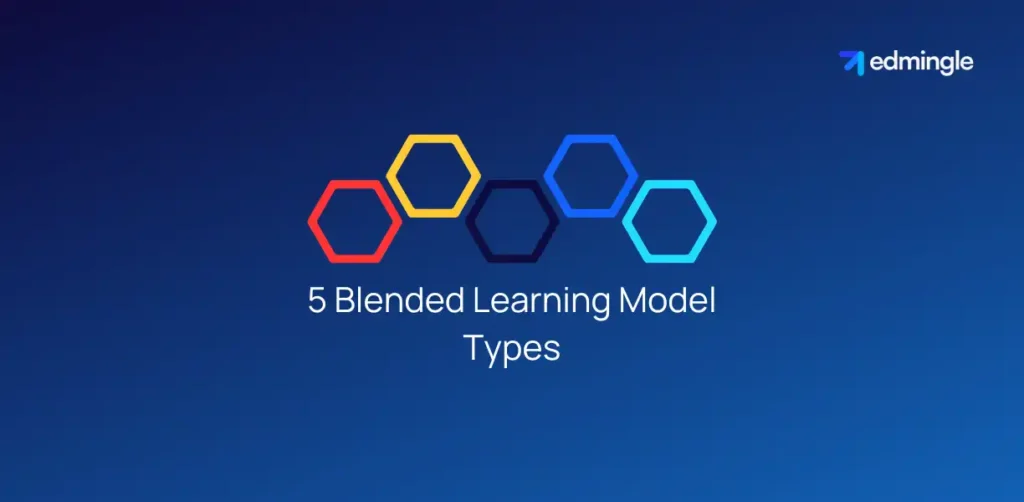
Blended training models are designed to offer diverse ways of integrating online & face-to-face instruction. Mainly with the aim to best suit diverse learner needs.
Here are some of the most prominent types of blended models:
1.Rotational Model:
In this, students rotate between different stations on a fixed schedule. Where at least one of the stations is digital. It’s sub-models include:
| Station Rotation: Students rotate through stations in a fixed sequence. With one station typically being e-learning. | Lab Rotation: Students rotate to a computer lab for the online segment of training. |
| Flipped Classroom: Students learn content online & outside of the classroom. And then come to class for face-to-face guidance and application. | Individual Rotation: Students rotate through stations. But the sequence is personalized based on individual needs. |
2.Flex Model:
Here, most of the curriculum is delivered digitally. Face-to-face instruction is offered on a flexible, as-needed basis through social learning activities. Like small-group instruction, group projects or individual tutoring.
3.A La Carte Model/Self-Blend Model:
Students take courses entirely online to complement their traditional courses. This allows learners to take up courses not offered at their school. Or to restart or accelerate their training/upskilling.
Also Read: LMS for Online Teaching.
4.Enriched Virtual Model:
Learners split their class time between attending offline classes & distance learning via online content. This model was initially developed for full-time online schools. As they used to offer students an in-person experience for at least a few days each week.
5.Project-Based:
Students engage in projects that require both online activity and hands-on work. This model allows teachers to closely monitor students’ progress. And intervene directly when necessary.
In short, there are various models by which you can approach the blended model. However, your choice will depend on the available resources and learner & trainer needs.
Top 10 LMS for Blended Learning in 2024
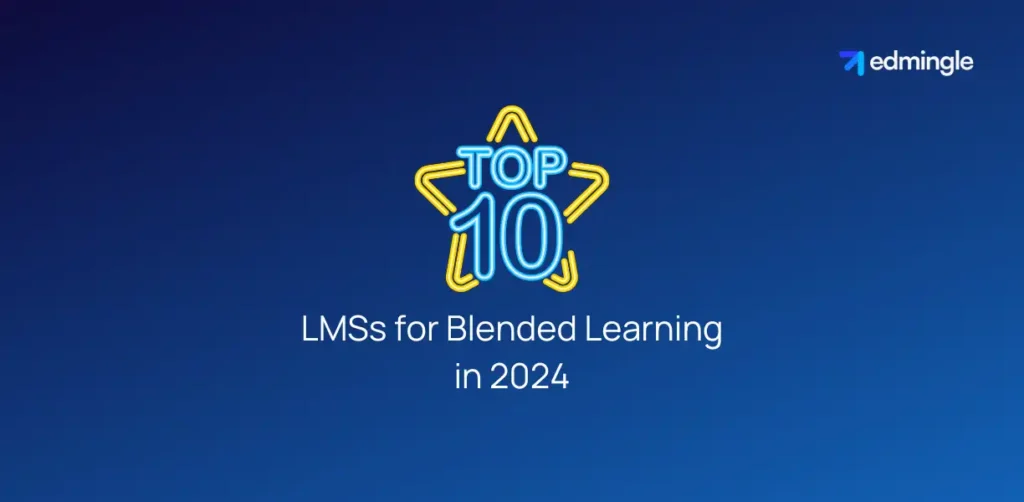
Amidst the fast adoption of new educational methods, LMSs continue to revolutionize learning. Modern LMS platforms have become entire ecosystems within themselves.
Let’s explore the top 10 LMS platforms for blended learning.
1.Edmingle
A rapidly growing SaaS LMS provider. Edmingle is known for its robust integrations, user-friendliness and exceptional customer support & service. Along with a wide range of useful features, it caters to 2.5M+ learners from across 130+ countries.
It’s been ranked in the Top 4 LMS Software in India by Capterra and #1 in the list of 20 Best LMSs of 2023 by Software Suggest.
2.Canvas
Known for its user-friendly interface and robust feature set. Canvas facilitates educators to add digital elements into their curriculum.
3.Moodle
An open-source LMS, Moodle can be customized by institutions. According to their specific blended training needs.
Related article: Cloud-Based LMS vs Open-Source LMS.
4.Blackboard Learn
Blackboard Learn stands out for its comprehensive suite of tools & scalability. It caters to educational institutions of all sizes.
5.iSpring Learn
With features like detailed reporting, quizzes and interactive assignments. iSpring Learn makes tracking and enhancing learner engagement straightforward.
6.TalentLMS
TalentLMS is an easy to use platform that supports blended learning. Through a mix of online, in-person and hybrid training sessions.
7.Docebo
Docebo, known for its AI-powered LMS, delivers personalized experiences. It supports both formal and informal strategies.
8. Schoology
Schoology excels in fostering collaboration among students and teachers. Its strength lies in its social media-like interface, which encourages interaction and engagement.
9.ProProfs
ProProfs LMS is known for its user-friendly design tools for creating engaging online courses. It provides features for real-time performance tracking and feedback.
To know in detail about core LMS features, check our blog on learning management system features.
10.360Learning
360Learning stands out for its collaborative approach while emphasizing a “hands-on/practical” methodology.
Each of these LMS platforms brings unique strengths to a blended strategy. By catering to different needs and preferences.
When choosing the right LMS for your organization, consider ease of use, scalability and integration capabilities. Apart from the specific features that align with your educational technologies, goals and strategies.
How to Select the Right LMS for Blended Learning?
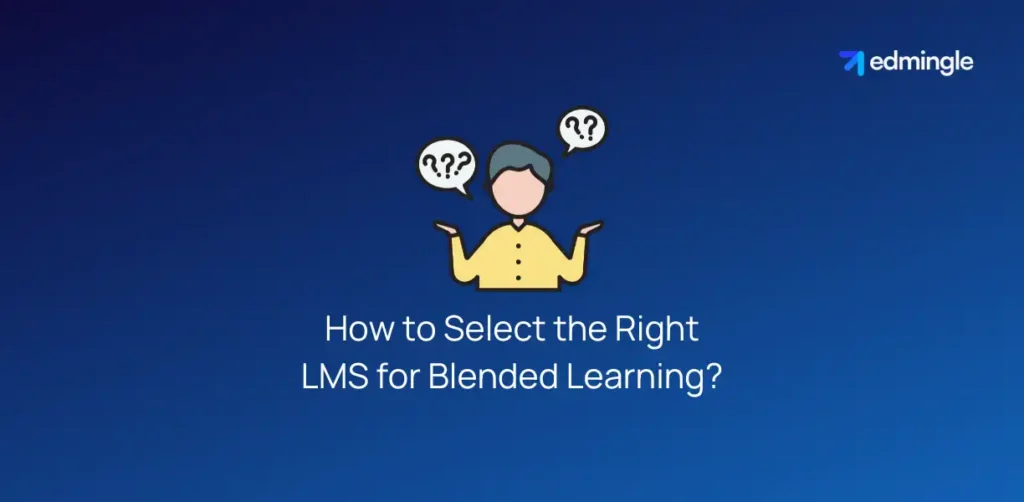
Selecting the right LMS for blended learning involves considering several factors. To ensure this platform supports your educational goals and meets the needs of both instructors and learners.
Here’s a brief guide on how to choose the right LMS:
1.Define Your Objectives: Understand what you want to achieve with your blended learning program. This will guide your selection process towards an LMS that supports these goals. Whether it’s improving engagement, flexibility or offering personalized learning paths.
2.Consider User Experience (UX): The LMS should be intuitive and easy to navigate for both teachers and students.
3.Evaluate Content Compatibility and Creation Tools: Ensure the LMS supports the creation & hosting of the type of content you plan to use (videos, interactive content, documents, etc.).
4.Assess Blended Features: Look for features that support a blend of synchronous and asynchronous learning. Such as live video conferencing tools, discussion forums and flexible assignment submission options.
5.Check for Scalability and Integration: The LMS should be able to grow with your program. And integrate smoothly with other tools & systems used by your organization.
6.Analyze Data and Reporting Capabilities: Strong analytics and reporting functions are essential for tracking student progress and learning outcomes. This data can then be used to form teaching strategies.
7.Review Support and Training Options: Consider the level of support and training provided by the LMS vendor.
8.Understand Pricing and Exploring Firsthand: Finally, review the LMS pricing structure and take an LMS demo. To ensure it fits your budget and expectations, also consider the ongoing fees.
By carefully evaluating these factors, you can select an LMS that fits your blended learning strategy. While also enhancing the teaching and online learning experience.
Also read about the differences between Active Learning vs Passive Learning.
6 Best Practices for Implementing Blended Learning
With all the benefits and potential drawbacks for safety, comes the need for a proper implementation. Majorly, for blended learning to be truly effective.
Here are some best practices to consider as you embark on or refine your blended training journey.
| 1.Design with the Learner in Mind Recognize that each learner is unique. Use personalized learning pathways that adjust based on individual student progress and performance. Ensure all online resources are accessible across various devices and for all learners. Responsive design and alternative formats (like transcripts for videos) can be beneficial. |
| 2.Integrate Seamlessly It’s crucial that both the online and offline elements complement each other. Guide learners as they transition between online and offline activities. Provide clear instructions and checkpoints to facilitate this movement. |
| 3.Foster Community and Collaboration Use collaborative online tools like discussion forums, group projects and peer reviews. To foster a sense of community among learners. Whether it’s feedback on assignments or answering queries. Timely communication keeps learners engaged and informed. |
| 4.Prioritize Flexibility but Set Clear Expectations Give learners the autonomy to progress at their pace in online segments. But provide guidance and support when needed. While flexibility is key, it’s also essential to have clear deadlines for assignments and assessments to maintain structure. |
| 5.Continually Assess and Adjust Blend traditional tests with online quizzes, projects and real-world applications to gauge learner understanding comprehensively. Regularly gather feedback from students about their blended learning experience. This will provide insights into what’s working and the areas for improvement. |
| 6.Invest in Professional Development The success of the blended approach often hinges on the educator’s comfort with the format. Invest in regular training to ensure they’re up-to-date with the latest tools & strategies. |
The power of blended learning lies in its hybrid nature. Drawing the strengths from both traditional and digital methodologies. By focusing on these 6 aspects, you can ensure a seamless & thriving learning environment.
Conclusion
As we’ve explored, the blended learning approach is not just a buzzword but the pulse of modern education. And it is seeing widespread adoption.
Amidst this, it’s crucial to understand the subtle differences it has with hybrid learning and to be aware of its potential pitfalls. Yet, with the right LMS in place, many of these challenges can be mitigated.
The LMS landscape in 2024 offers a plethora of options. Each tailored to enhance and streamline the blended experience. It’s an evolving landscape and as technology continues to advance, the potential for blended learning will only grow.
FAQs on Blended Learning
What to look for, technologically, in blended learning?
When exploring technology, consider the following: user-friendliness, flexibility, interactivity, scalability, analytics and integration.
Is blended learning good for me & my learners?
The blended learning method can offer numerous advantages. Such as personalized paths, flexibility in pacing and increased engagement. However, its success depends on factors like access to technology, user’s comfort with digital tools, learning objectives and learner preferences.
Can blended learning be applied to all subjects?
Yes, blended learning can be applied to nearly all subjects. The key is to effectively integrate online and in-person elements in a way that complements the subject matter.
What are the key components of a successful blended learning program?
A successful blended learning program includes a mix of synchronous (real-time) & asynchronous (on your own time) activities. Along with the effective use of technology, engaging & interactive content and opportunities for collaboration among students. Regular feedback and support from instructors are also crucial.
How can parents support their children in a blended learning environment?
Parents can support their children by providing a conducive learning environment at home. While encouraging regular study habits and showing interest in their learning activities. It’s also important for them to stay informed about the learning objectives and progress.

Leave a Reply